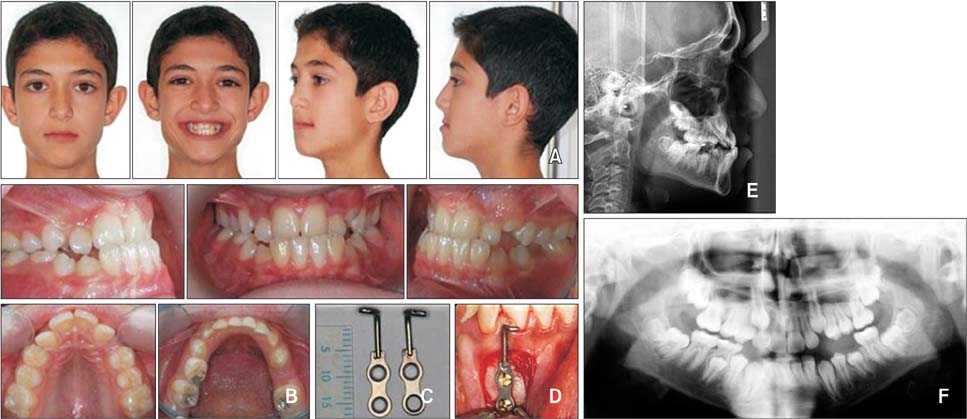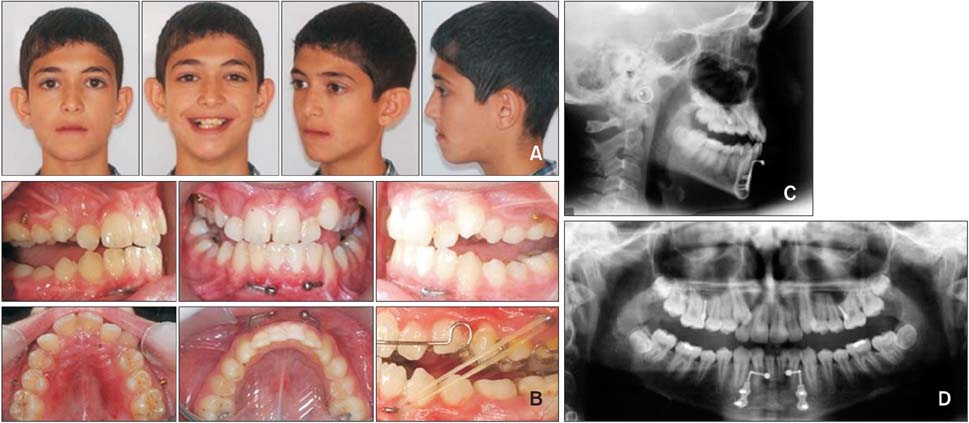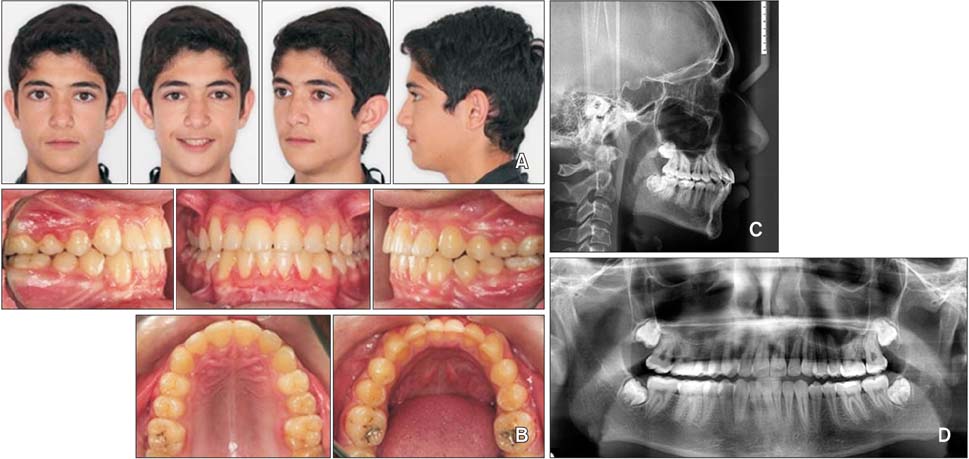Korean J Orthod.
2015 Mar;45(2):95-101. 10.4041/kjod.2015.45.2.95.
Maxillary protraction using skeletal anchorage and intermaxillary elastics in Skeletal Class III patients
- Affiliations
-
- 1Department of Orthodontics, Faculty of Dentistry, University of Suleyman Demirel, Isparta, Turkey. elcinesenlik@gmail.com
- 2Department of Orthodontics, Faculty of Dentistry, University of Sifa, Izmir, Turkey.
- 3Department of Oral and Maxillofacial Surgery, Faculty of Dentistry, University of Suleyman Demirel, Isparta, Turkey.
- KMID: 1787611
- DOI: http://doi.org/10.4041/kjod.2015.45.2.95
Abstract
- The aim of this case report is to describe the treatment of a patient with skeletal Class III malocclusion with maxillary retrognathia using skeletal anchorage devices and intermaxillary elastics. Miniplates were inserted between the mandibular lateral incisor and canine teeth on both sides in a male patient aged 14 years 5 months. Self-drilling mini-implants (1.6 mm diameter, 10 mm length) were installed between the maxillary second premolar and molar teeth, and Class III elastics were used between the miniplates and miniscrews. On treatment completion, an increase in the projection of the maxilla relative to the cranial base (2.7 mm) and significant improvement of the facial profile were observed. Slight maxillary counterclockwise (1degrees) and mandibular clockwise (3.3degrees) rotations were also observed. Maxillary protraction with skeletal anchorage and intermaxillary elastics was effective in correcting a case of Skeletal Class III malocclusion without dentoalveolar side effects.
Figure
Cited by 2 articles
-
Maxillary protraction using customized mini-plates for anchorage in an adolescent girl with skeletal Class III malocclusion
Shuran Liang, Xianju Xie, Fan Wang, Qiao Chang, Hongmei Wang, Yuxing Bai
Korean J Orthod. 2020;50(5):346-355. doi: 10.4041/kjod.2020.50.5.346.Short-term and long-term treatment outcomes with Class III activator
Hyo-kyung Ryu, Hyun-Jeong Chong, Ki-Yong An, Kyung-hwa Kang
Korean J Orthod. 2015;45(5):226-235. doi: 10.4041/kjod.2015.45.5.226.
Reference
-
1. Klempner LS. Early orthopedic Class III treatment with a modified tandem appliance. J Clin Orthod. 2003; 37:218–223.2. Chun YS, Jeong SG, Row J, Yang SJ. A new appliance for orthopedic correction of Class III malocclusion. J Clin Orthod. 1999; 33:705–711.3. Enacar A, Giray B, Pehlivanoglu M, Iplikcioglu H. Facemask therapy with rigid anchorage in a patient with maxillary hypoplasia and severe oligodontia. Am J Orthod Dentofacial Orthop. 2003; 123:571–577.
Article4. Kircelli BH, Pektas ZO. Midfacial protraction with skeletally anchored face mask therapy: a novel approach and preliminary results. Am J Orthod Dentofacial Orthop. 2008; 133:440–449.
Article5. De Clerck HJ, Cornelis MA, Cevidanes LH, Heymann GC, Tulloch CJ. Orthopedic traction of the maxilla with miniplates: a new perspective for treatment of midface deficiency. J Oral Maxillofac Surg. 2009; 67:2123–2129.
Article6. Cevidanes L, Baccetti T, Franchi L, McNamara JA Jr, De Clerck H. Comparison of two protocols for maxillary protraction: bone anchors versus face mask with rapid maxillary expansion. Angle Orthod. 2010; 80:799–806.
Article7. Ge YS, Liu J, Chen L, Han JL, Guo X. Dentofacial effects of two facemask therapies for maxillary protraction. Angle Orthod. 2012; 82:1083–1091.
Article8. De Clerck EE, Swennen GR. Success rate of miniplate anchorage for bone anchored maxillary protraction. Angle Orthod. 2011; 81:1010–1013.
Article9. Koh SD, Chung DH. Comparison of skeletal anchored facemask and tooth-borne facemask according to vertical skeletal pattern and growth stage. Angle Orthod. 2014; 84:628–633.
Article10. Cha BK, Choi DS, Ngan P, Jost-Brinkmann PG, Kim SM, Jang IS. Maxillary protraction with miniplates providing skeletal anchorage in a growing Class III patient. Am J Orthod Dentofacial Orthop. 2011; 139:99–112.
Article11. Ahn HW, Kim KW, Yang IH, Choi JY, Baek SH. Comparison of the effects of maxillary protraction using facemask and miniplate anchorage between unilateral and bilateral cleft lip and palate patients. Angle Orthod. 2012; 82:935–941.
Article12. Kaya D, Kocadereli I, Kan B, Tasar F. Effects of facemask treatment anchored with miniplates after alternate rapid maxillary expansions and constrictions; a pilot study. Angle Orthod. 2011; 81:639–646.
Article13. De Clerck H, Cevidanes L, Baccetti T. Dentofacial effects of bone-anchored maxillary protraction: a controlled study of consecutively treated Class III patients. Am J Orthod Dentofacial Orthop. 2010; 138:577–581.
Article14. Sar C, Arman-Özçırpıcı A, Uçkan S, Yazıcı AC. Comparative evaluation of maxillary protraction with or without skeletal anchorage. Am J Orthod Dentofacial Orthop. 2011; 139:636–649.
Article
- Full Text Links
- Actions
-
Cited
- CITED
-
- Close
- Share
- Similar articles
-
- Does surgically assisted maxillary protraction with skeletal anchorage and Class III elastics affect the pharyngeal airway? A retrospective, long-term study
- Maxillary protraction treatment of skeletal Class III children using miniplate anchorage
- Treatment of skeletal Class III malocclustion with maxillary protraction appliance
- Maxillary protraction using customized mini-plates for anchorage in an adolescent girl with skeletal Class III malocclusion
- Directional forces using skeletal anchorage for treatment of skeletal Class II div.1 malocclusion




